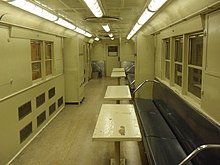| This article needs additional citations for verification. Please help improve this article by adding citations to reliable sources. Unsourced material may be challenged and removed. Find sources: "Money train" – news · newspapers · books · scholar · JSTOR (October 2015) (Learn how and when to remove this message) |


A money train is one or more railcars used to collect cash fare revenue from stations on a subway system and return it to a central location for processing. This train was typically used to carry money bags guarded by transit police to deter robberies.
On the New York City Subway, a "money train" was first mentioned in 1905, a year after the system opened. Their trains were converted from subway cars that have been removed from passenger service. This has since been discontinued, with the last service running in January 2006. Two of the cars are preserved by the New York Transit Museum in Brooklyn.
The use of a train was necessary because of difficulties in getting to and from stations using over-street transport, and because, since the subway reaches every station, the rail system itself can be used to collect money from ticket machines. The 1995 American crime thriller film Money Train depicts a robbery of such a train.
Singapore's Mass Rapid Transit system introduced a money train (cash train) where a specially modified Driving Trailer car is coupled to a regular 3 car C151 train when the system was commissioned in 1987. Used to transfer cash trolleys from stations to a counting facility at Bishan Depot, the increased use of stored value tickets resulted in the train being decommissioned in 2007.
The Washington Metro system continues to use money trains as of August 2024.
The Light Rail in Hong Kong uses money trains, which are regular passenger trains taken out of service, to collect fares from the ticket vending machines.
Pay car
Main article: Pay carIn Australia, the reverse procedure occurred with the New South Wales Government Railways fleet of pay buses. A small self-powered railcar, they were used to deliver pay packets containing cash to employees at remote railway stations, as well as maintenance gangs working on the tracks. This operation remained in service until the 1980s when it was supplanted by electronic payments.
References
- ^ Vandam, Jeff (December 31, 2006). "Cash and Carry". New York Times. Retrieved December 24, 2010.
- "Fare Payment Evolution: Interview". Moving Stories. SMRT. Archived from the original on 6 August 2015. Retrieved 7 August 2015.
- "Ca$h On Track, The Story of the Rail Pay Bus". NSW Rail Heritage. www.nswrailheritage.com.au. Archived from the original on December 8, 2010. Retrieved January 4, 2011.
| Public transport | |
|---|---|
| Bus service | |
| Rail | |
| Vehicles for hire | |
| Carpooling | |
| Ship | |
| Cable | |
| Other transport | |
| Locations | |
| Ticketing and fares |
|
| Routing | |
| Facilities | |
| Scheduling | |
| Politics | |
| Technology and signage | |
| Other topics | |
| New York City Subway rolling stock | |||||||||||||
|---|---|---|---|---|---|---|---|---|---|---|---|---|---|
| Current |
| ||||||||||||
| Future |
| ||||||||||||
| Retired (R-type) |
| ||||||||||||
| Retired (private operators) |
| ||||||||||||
| Experimental | |||||||||||||
| Work trains | |||||||||||||
| Never built | |||||||||||||
| See also: R-type contracts | |||||||||||||
| Rail transport freight rolling stock | |
|---|---|
| Enclosed equipment | |
| Open equipment |
|
| Non-revenue equipment | |
This United States train or rolling stock-related article is a stub. You can help Misplaced Pages by expanding it. |
This New York City transportation–related article is a stub. You can help Misplaced Pages by expanding it. |